Identifying the Spatial–Temporal Pattern of Cropland’s Non-Grain Production and Its Effects on Food Security in China
Abstract
1. Introduction
2. Theoretical Framework
2.1. Connotation Definition
2.2. Analysis Framework
3. Materials and Methods
3.1. Methods
3.1.1. Measurement of NGPCL
3.1.2. Kernel Density Estimation
3.1.3. Spatial Autocorrelation Analysis
3.1.4. Spatial Econometric Model
3.2. Variable Selection
3.3. Data Sources
4. Results
4.1. The Overall Trend of NGPCL in China
4.2. The Spatial Pattern of NGPCL in China
4.3. The Spatial Agglomeration Characteristics of NGPCL in China
4.4. Influencing Factors of Spatial–Temporal Pattern Change in NGPCL
5. Discussion
5.1. NGPCL Serves as a Challenge to Food Security in the New Era
5.2. Control Measures Should Be Matched with the Differentiated Pattern of NGPCL
5.3. Targeted Managements Are Required Based on the Perspective of the Human–Land Relationship
6. Conclusions
Author Contributions
Funding
Data Availability Statement
Acknowledgments
Conflicts of Interest
References
- Kinnunen, P.; Guillaume, J.H.A.; Taka, M.; D’Odorico, P.; Siebert, S.; Puma, M.J.; Jalava, M.; Kummu, M. Local food crop production can fulfil demand for less than one-third of the population. Nat. Food 2020, 1, 229–237. [Google Scholar] [CrossRef]
- Viana, C.M.; Freire, D.; Abrantes, P.; Rocha, J.; Pereira, P. Agricultural land systems importance for supporting food security and sustainable development goals: A systematic review. Sci. Total Environ. 2021, 806, 150718. [Google Scholar] [CrossRef] [PubMed]
- Suweis, S.; Carr, J.A.; Maritan, A.; Rinaldo, A.; D’Odorico, P. Resilience and reactivity of global food security. Proc. Natl. Acad. Sci. USA 2015, 112, 6902–6907. [Google Scholar] [CrossRef] [PubMed]
- Tian, X.; Engel, B.A.; Qian, H.; Hua, E.; Sun, S.; Wang, Y. Will reaching the maximum achievable yield potential meet future global food demand? J. Clean. Prod. 2021, 294, 126285. [Google Scholar] [CrossRef]
- Wang, X.; Qiang, W.; Niu, S.; Growe, A.; Yan, S.; Tian, N. Multi-Scenario Simulation Analysis of Grain Production and Demand in China during the Peak Population Period. Foods 2022, 11, 1566. [Google Scholar] [CrossRef]
- D’Amour, C.B.; Reitsma, F.; Baiocchi, G.; Barthel, S.; Güneralp, B.; Erb, K.H.; Haberl, H.; Creutzig, F.; Seto, K.C. Future urban land expansion and implications for global croplands. Proc. Natl. Acad. Sci. USA 2017, 114, 8939–8944. [Google Scholar] [CrossRef]
- Yang, H.; Li, X. Cultivated land and food supply in China. Land Use Policy 2000, 17, 73–88. [Google Scholar] [CrossRef]
- Ciani, M.; Lippolis, A.; Fava, F.; Rodolfi, L.; Niccolai, A.; Tredici, M. Microbes: Food for the Future. Foods 2021, 10, 971. [Google Scholar] [CrossRef]
- Su, Y.; Qian, K.; Lin, L.; Wang, K.; Guan, T.; Gan, M. Identifying the driving forces of non-grain production expansion in rural China and its implications for policies on cultivated land protection. Land Use Policy 2020, 92, 104435. [Google Scholar] [CrossRef]
- Li, Y.; Zhao, B.; Huang, A.; Xiong, B.; Song, C. Characteristics and Driving Forces of Non-Grain Production of Cultivated Land from the Perspective of Food Security. Sustainability 2021, 13, 14047. [Google Scholar] [CrossRef]
- Henchion, M.; Hayes, M.; Mullen, A.M.; Fenelon, M.; Tiwari, B. Future Protein Supply and Demand: Strategies and Factors Influencing a Sustainable Equilibrium. Foods 2017, 6, 53. [Google Scholar] [CrossRef] [PubMed]
- Zhou, Y.; Li, X.; Liu, Y. Cultivated land protection and rational use in China. Land Use Policy 2021, 106, 105454. [Google Scholar] [CrossRef]
- Zhang, Y.; Li, B. Detection of the Spatio-Temporal Differentiation Patterns and Influencing Factors of Wheat Production in Huang-Huai-Hai Region. Foods 2022, 11, 1617. [Google Scholar] [CrossRef] [PubMed]
- Sun, Y.; Chang, Y.; Liu, J.; Ge, X.; Liu, G.-J.; Chen, F. Spatial Differentiation of Non-Grain Production on Cultivated Land and Its Driving Factors in Coastal China. Sustainability 2021, 13, 13064. [Google Scholar] [CrossRef]
- Pan, J.W.; Chen, Y.; Zhang, Y.; Chen, M.; Fennell, S.; Luan, B.; Wang, F.; Meng, D.; Liu, Y.; Jiao, L.; et al. Spatial-temporal dynamics of grain yield and the potential driving factors at the county level in China. J. Clean. Prod. 2020, 255, 120312. [Google Scholar] [CrossRef]
- Mzyece, A.; Ng’Ombe, J.N. Crop diversification improves technical efficiency and reduces income variability in Northern Ghana. J. Agric. Food Res. 2021, 5, 100162. [Google Scholar] [CrossRef]
- Beillouin, D.; Ben-Ari, T.; Makowski, D. A dataset of meta-analyses on crop diversification at the global scale. Data Brief 2019, 24, 103898. [Google Scholar] [CrossRef]
- Yu, M.; Yang, Y.; Chen, F.; Zhu, F.; Qu, J.; Zhang, S. Response of agricultural multifunctionality to farmland loss under rapidly urbanizing processes in Yangtze River Delta, China. Sci. Total Environ. 2019, 666, 1–11. [Google Scholar] [CrossRef]
- Renting, H.; Rossing, W.; Groot, J.; Van der Ploeg, J.; Laurent, C.; Perraud, D.; Stobbelaar, D.; Van Ittersum, M. Exploring multifunctional agriculture. A review of conceptual approaches and prospects for an integrative transitional framework. J. Environ. Manag. 2009, 90, S112–S123. [Google Scholar] [CrossRef]
- Jiang, G.; Wang, M.; Qu, Y.; Zhou, D.; Ma, W. Towards cultivated land multifunction assessment in China: Applying the “influencing factors-functions-products-demands” integrated framework. Land Use Policy 2020, 99, 104982. [Google Scholar] [CrossRef]
- Guo, Y.; Wang, J. Identifying the Determinants of Nongrain Farming in China and Its Implications for Agricultural Development, in Land. Land 2021, 10, 902. [Google Scholar] [CrossRef]
- Leng, Z.; Wang, Y.; Hou, X. Structural and Efficiency Effects of Land Transfers on Food Planting: A Comparative Perspective on North and South of China. Sustainability 2021, 13, 3327. [Google Scholar] [CrossRef]
- Han, H.Y.; Lin, H. Patterns of Agricultural Diversification in China and Its Policy Implications for Agricultural Modernization. Int. J. Environ. Res. Public Health 2021, 18, 4978. [Google Scholar] [CrossRef] [PubMed]
- Yan, J.; Yang, Z.; Li, Z.; Li, X.; Xin, L.; Sun, L. Drivers of cropland abandonment in mountainous areas: A household decision model on farming scale in Southwest China. Land Use Policy 2016, 57, 459–469. [Google Scholar] [CrossRef]
- Maryati, S.; Humaira, A.N.S.; Pratiwi, F. Spatial pattern of agricultural land conversion in West Java Province. IOP Conf. Ser. Earth Environ. Sci. 2018, 131, 12034. [Google Scholar] [CrossRef]
- Su, Y.; He, S.; Wang, K.; Shahtahmassebi, A.R.; Zhang, L.; Zhang, J.; Zhang, M.; Gan, M. Quantifying the sustainability of three types of agricultural production in China: An emergy analysis with the integration of environmental pollution. J. Clean. Prod. 2019, 252, 119650. [Google Scholar] [CrossRef]
- Yang, Q.; Zhang, D.J. The influence of agricultural industrial policy on non-grain production of cultivated land: A case study of the "one village, one product" strategy implemented in Guanzhong Plain of China. Land Use Policy 2021, 108, 105579. [Google Scholar] [CrossRef]
- Yu, D.; Hu, S.; Tong, L.; Xia, C.; Ran, P. Dynamics and Determinants of the Grain Yield Gap in Major Grain-Producing Areas: A Case Study in Hunan Province, China. Foods 2022, 11, 1122. [Google Scholar] [CrossRef]
- Chen, F.; Liu, J.N.; Chang, Y.Y.; Zhang, Q.; Yu, H.C.; Zhang, S.L. Spatial Pattern Differentiation of Non-grain Cultivated Land and Its Driving Factors in China. China Land Sci. 2021, 35, 33–43. (In Chinese) [Google Scholar]
- Qi, Y.; Li, Y.; Zhu, D. Study on the Non-grain Utilization of Cultivated Land from the Perspective of Cultivated Land Capitalization. China Land Sci. 2021, 35, 47–56. [Google Scholar]
- Ramankutty, N.; Evan, A.T.; Monfreda, C.; Foley, J.A. Farming the planet: 1. Geographic distribution of global agricultural lands in the year 2000. Glob. Biogeochem. Cycles 2008, 22, 1. [Google Scholar] [CrossRef]
- Adkins, K.; Boyer, C.N.; Smith, S.A.; Griffith, A.P.; Muhammad, A. Analyzing corn and cotton producers optimal prevented planting decision on moral hazard. Agron. J. 2020, 112, 2047–2057. [Google Scholar] [CrossRef]
- Zhu, C.; Dong, B.; Li, S.; Lin, Y.; Shahtahmassebi, A.; You, S.; Zhang, J.; Gan, M.; Yang, L.; Wang, K. Identifying the trade-offs and synergies among land use functions and their influencing factors from a geospatial perspective: A case study in Hangzhou, China. J. Clean. Prod. 2021, 314, 128026. [Google Scholar] [CrossRef]
- Fan, M.; Shen, J.; Yuan, L.; Jiang, R.; Chen, X.; Davies, W.J.; Zhang, F. Improving crop productivity and resource use efficiency to ensure food security and environmental quality in China. J. Exp. Bot. 2011, 63, 13–24. [Google Scholar] [CrossRef]
- Chen, W.; Zeng, J.; Li, N. Change in land-use structure due to urbanisation in China. J. Clean. Prod. 2021, 321, 128986. [Google Scholar] [CrossRef]
- Zhao, X.; Zheng, Y.; Huang, X.; Kwan, M.-P.; Zhao, Y. The Effect of Urbanization and Farmland Transfer on the Spatial Patterns of Non-Grain Farmland in China. Sustainability 2017, 9, 1438. [Google Scholar] [CrossRef]
- Cao, H.; Zhu, X.; Heijman, W.; Zhao, K. The impact of land transfer and farmers’ knowledge of farmland protection policy on pro-environmental agricultural practices: The case of straw return to fields in Ningxia. China. J. Clean. Prod. 2020, 277, 123701. [Google Scholar] [CrossRef]
- Ji, Y.; Li, Y.; Yao, N.; Biswas, A.; Chen, X.; Li, L.; Pulatov, A.; Liu, F. Multivariate global agricultural drought frequency analysis using kernel density estimation. Ecol. Eng. 2022, 177, 106550. [Google Scholar] [CrossRef]
- Xin-gang, Z.; Fan, L. Spatial distribution characteristics and convergence of China’s regional energy intensity: An industrial transfer perspective. J. Clean. Prod. 2019, 233, 903–917. [Google Scholar] [CrossRef]
- Coelho, L.M.; da Costa Martins, K.d.L.; de Almeida, P.A.L.; da Silva, M.B.V. Spatial distribution of firewood production in northeastern brazil (1994–2013). Rev. Arvore 2018, 42, 4. [Google Scholar]
- Qiu, L.; Zhu, J.; Pan, Y.; Wu, S.; Dang, Y.; Xu, B.; Yang, H. The positive impacts of landscape fragmentation on the diversification of agricultural production in Zhejiang Province, China. J. Clean. Prod. 2020, 251, 119722. [Google Scholar] [CrossRef]
- Deng, X.; Gibson, J.; Wang, P. Relationship between landscape diversity and crop production: A case study in the Hebei Province of China based on multi-source data integration. J. Clean. Prod. 2017, 142, 985–992. [Google Scholar] [CrossRef]
- Hou, M.; Deng, Y.; Yao, S. Coordinated relationship between urbanization and grain production in China: Degree measurement, spatial differentiation and its factors detection. J. Clean. Prod. 2021, 331, 129957. [Google Scholar] [CrossRef]
- Su, B.Z.; Li, Y.; Li, L.; Wang, Y. How does nonfarm employment stability influence farmers’ farmland transfer decisions? Implications for China’s land use policy. Land Use Policy 2018, 74, 66–72. [Google Scholar] [CrossRef]
- Zhu, Z.; Dai, Z.; Li, S.; Feng, Y. Spatiotemporal Evolution of Non-Grain Production of Cultivated Land and Its Underlying Factors in China. Int. J. Environ. Res. Public Health 2022, 19, 8210. [Google Scholar] [CrossRef]
- Wang, Y.; Li, X.; Lu, D.; Yan, J. Evaluating the impact of land fragmentation on the cost of agricultural operation in the southwest mountainous areas of China. Land Use Policy 2020, 99, 105099. [Google Scholar] [CrossRef]
- Su, Y.; Su, C.; Xie, Y.; Li, T.; Li, Y.; Sun, Y. Controlling Non-Grain Production Based on Cultivated Land Multifunction Assessment. Int. J. Environ. Res. Public Health 2022, 19, 1027. [Google Scholar] [CrossRef]
- Zhang, H.; Song, W.; Zhang, W.X.; Li, X.J.; Liu, J.Q.; Li, J.Y. Analysis of Spatial Differentiation Characteristics and Influencing Factors of Non-grain Cultivated Land in Shandong Province. China Land Sci. 2021, 35, 94–103. (In Chinese) [Google Scholar]
- Zhang, R.; Li, P.; Xu, L.; Zhong, S.; Wei, H. An integrated accounting system of quantity, quality and value for assessing cultivated land resource assets: A case study in Xinjiang, China. Glob. Ecol. Conserv. 2022, 36, e02115. [Google Scholar] [CrossRef]
- Qiu, T.; Choy, S.B.; Li, S.; He, Q.; Luo, B. Does land renting-in reduce grain production? Evidence from rural China. Land Use Policy 2020, 90, 104311. [Google Scholar] [CrossRef]
- Mann, M.L.; Kaufmann, R.K.; Bauer, D.; Gopal, S.; Vera-Diaz, M.D.C.; Nepstad, D.; Merry, F.; Kallay, J.; Amacher, G.S. The economics of cropland conversion in Amazonia: The importance of agricultural rent. Ecol. Econ. 2010, 69, 1503–1509. [Google Scholar] [CrossRef]
- Yu, X.; Sun, J.; Sun, S.; Yang, F.; Lu, Y.; Wang, Y.; Wu, F.; Liu, P. A comprehensive analysis of regional grain production characteristics in China from the scale and efficiency perspectives. J. Clean. Prod. 2018, 212, 610–621. [Google Scholar] [CrossRef]
- Zhang, Q.; Zhang, F.; Wu, G.; Mai, Q. Spatial spillover effects of grain production efficiency in China: Measurement and scope. J. Clean. Prod. 2021, 278, 121062. [Google Scholar] [CrossRef]
- Cheng, J.; Sun, J.; Yao, K.; Xu, M.; Cao, Y. A variable selection method based on mutual information and variance inflation factor. Spectrochim. Acta Part A Mol. Biomol. Spectrosc. 2021, 268, 120652. [Google Scholar] [CrossRef] [PubMed]
- Li, J.; Li, Z. Physical limitations and challenges to Grain Security in China. Food Secur. 2014, 6, 159–167. [Google Scholar] [CrossRef]
- Chai, J.; Wang, Z.; Yang, J.; Zhang, L. Analysis for spatial-temporal changes of grain production and farmland resource: Evidence from Hubei Province, central China. J. Clean. Prod. 2019, 207, 474–482. [Google Scholar] [CrossRef]
- Huang, H.; Hou, M.; Yao, S. Urbanization and Grain Production Pattern of China: Dynamic Effect and Mediating Mechanism. Agriculture 2022, 12, 539. [Google Scholar] [CrossRef]
- Kang, L.; Zhao, R.; Wu, K.; Huang, Q.; Zhang, S. Impacts of Farming Layer Constructions on Cultivated Land Quality under the Cultivated Land Balance Policy. Agronomy 2021, 11, 2403. [Google Scholar] [CrossRef]
- Liu, L.; Zhou, D.; Chang, X.; Lin, Z. A new grading system for evaluating China’s cultivated land quality. Land Degrad. Dev. 2020, 31, 1482–1501. [Google Scholar] [CrossRef]
- Song, W.; Zhang, H.; Zhao, R.; Wu, K.; Li, X.; Niu, B.; Li, J. Study on cultivated land quality evaluation from the perspective of farmland ecosystems. Ecol. Indic. 2022, 139, 108959. [Google Scholar] [CrossRef]
- Yang, X.; Sang, Y.; Zhang, A. How livelihood capital affects farmers’ willingness to pay for farmland non-market value? Evidence from Jianghan Plain, China. Environ. Sci. Pollut. Res. 2022, 29, 51456–51468. [Google Scholar] [CrossRef]
- Cao, Y.; Li, G.Y.; Wang, J.Y.; Fang, X.Q.; Sun, K.Y. Systematic Review and Research Framework of Non-grain Utilization of Cultivated Land: From a Perspective of Food Security to Multi-dimensional Security. China Land Sci. 2022, 36, 1–12. (In Chinese) [Google Scholar]
- Zhang, L.; Lin, X.; Qiu, B.; Ou, G.; Zhang, Z.; Han, S. Impact of Value Perception on Farmers’ Willingness to Participate in Farmland Fallow: A Case-Study in Major Grain-Producing Areas of Hubei and Hunan, China. Sustainability 2022, 14, 724. [Google Scholar] [CrossRef]
- Toma, P.; Miglietta, P.P.; Zurlini, G.; Valente, D.; Petrosillo, I. A non-parametric bootstrap-data envelopment analysis approach for environmental policy planning and management of agricultural efficiency in EU countries. Ecol. Indic. 2017, 83, 132–143. [Google Scholar] [CrossRef]
- Manta, F.; Morrone, D.; Toma, P.; Campobasso, F. Determining paths of innovation: The role of culture on the adoption on organic farming management. Bus. Strat. Environ. 2022. [Google Scholar] [CrossRef]
- Fusco, G.; Coluccia, B.; De Leo, F. Effect of Trade Openness on Food Security in the EU: A Dynamic Panel Analysis. Int. J. Environ. Res. Public Health 2020, 17, 4311. [Google Scholar] [CrossRef] [PubMed]
- Odoemena, B.; Eboh, E.; Okoli, P.; Uguwonnah, G. Econometric analysis of the micro-level determinants of woodland conversion to arable cropping and implications to policy in Eastern Nigeria. Afr. J. Agric. Res. 2010, 5, 1168–1178. [Google Scholar]
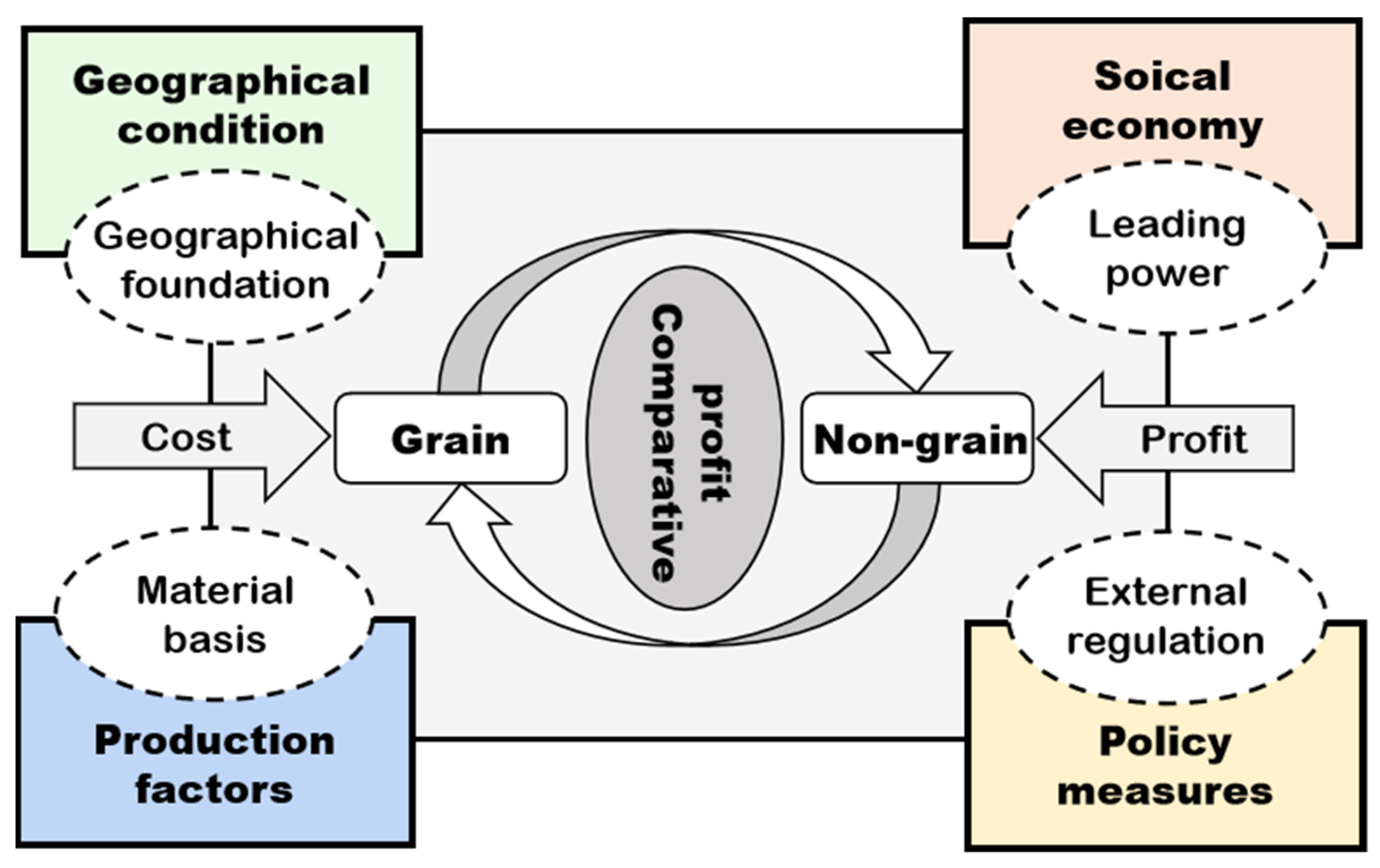
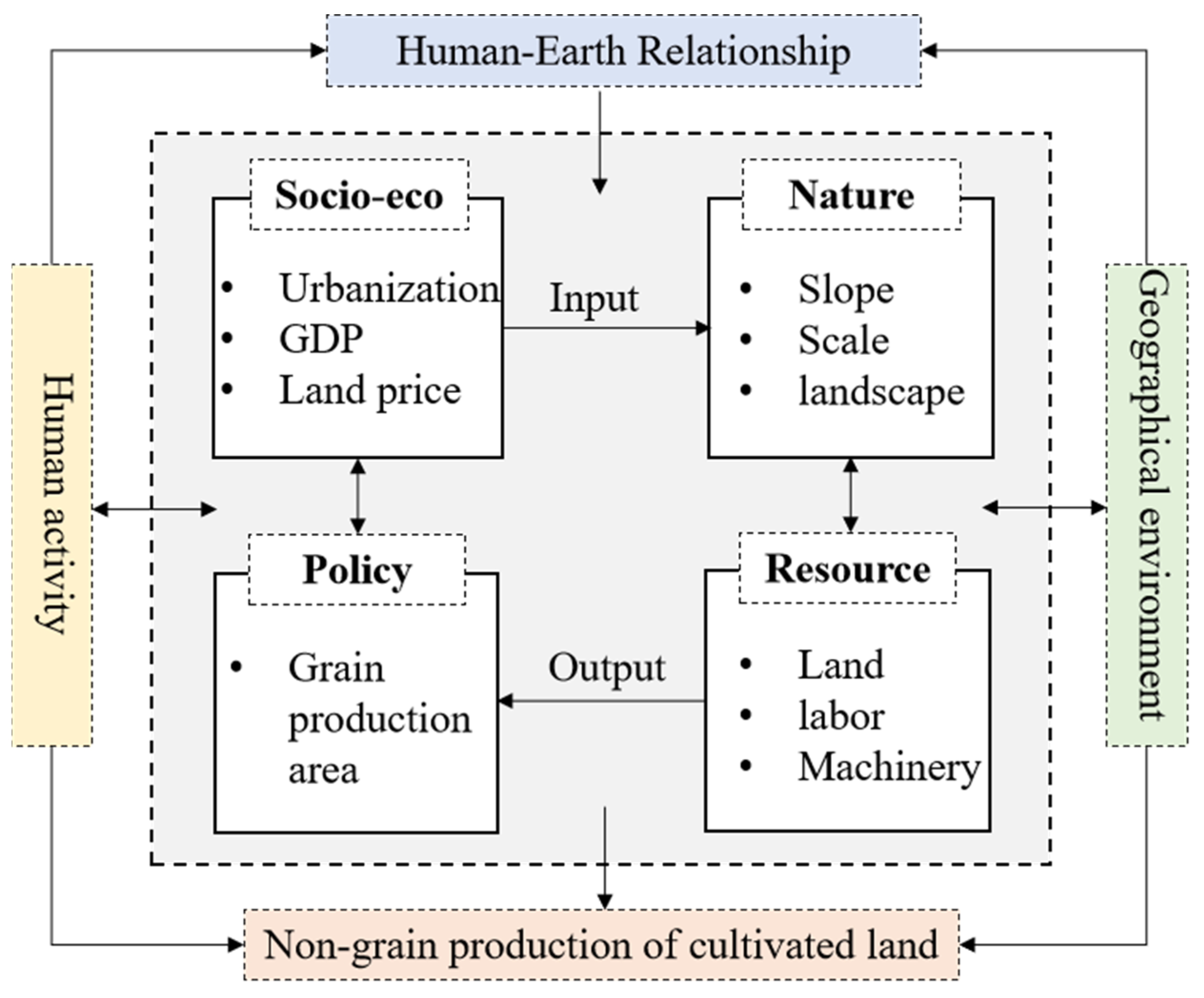
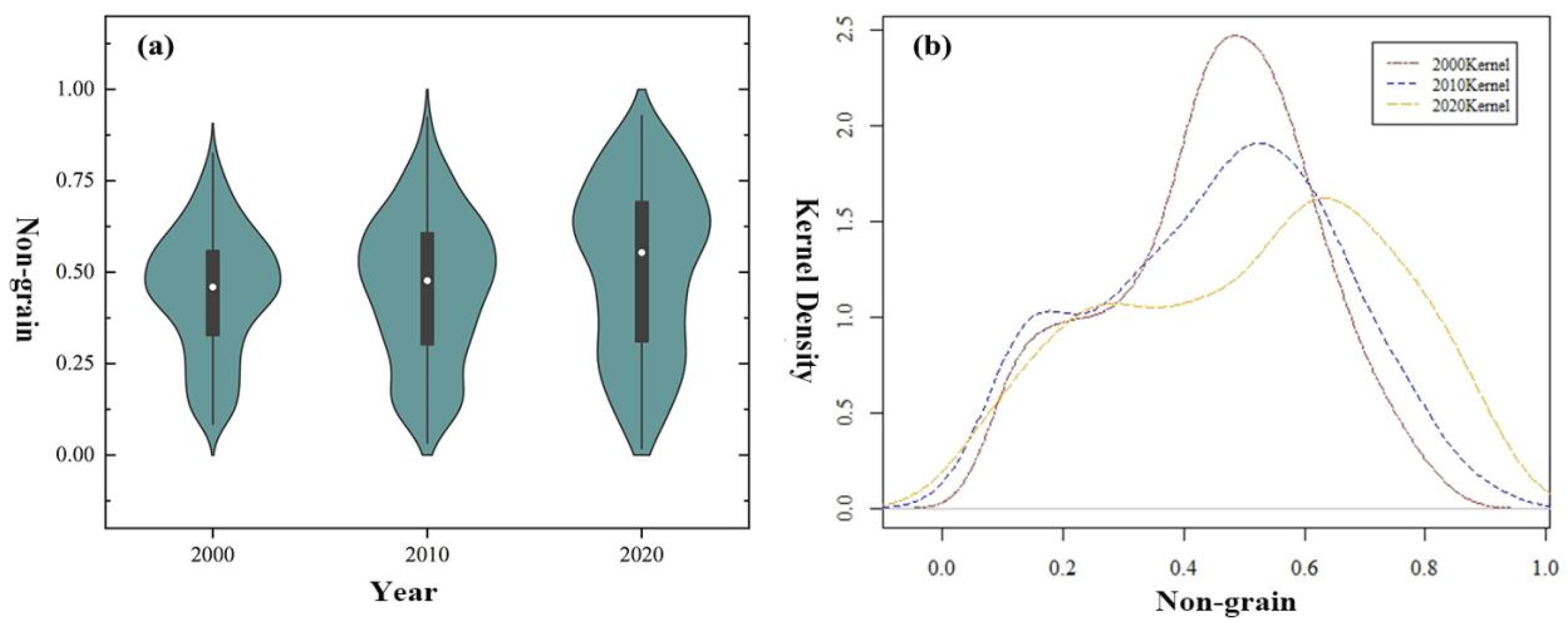
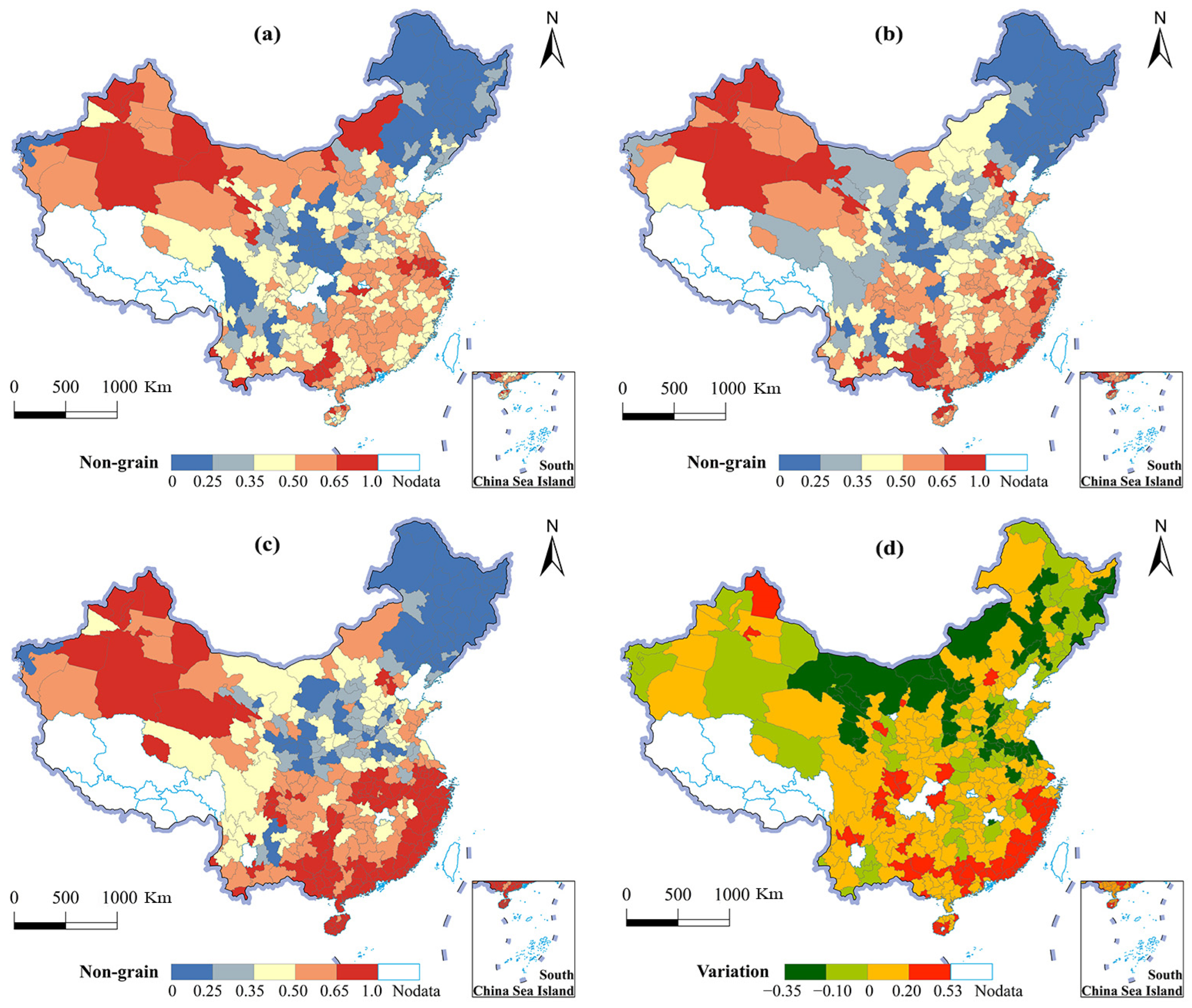
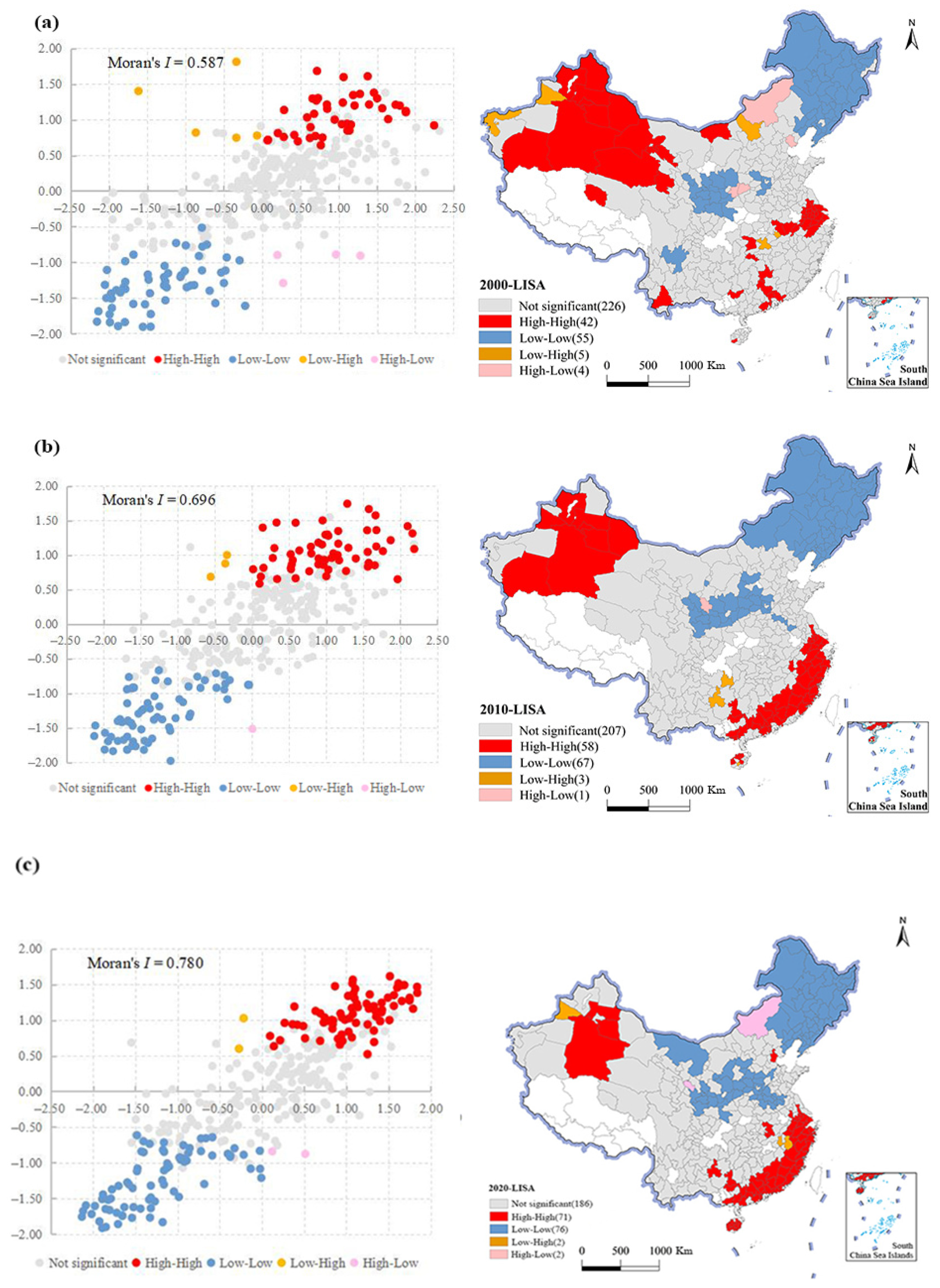
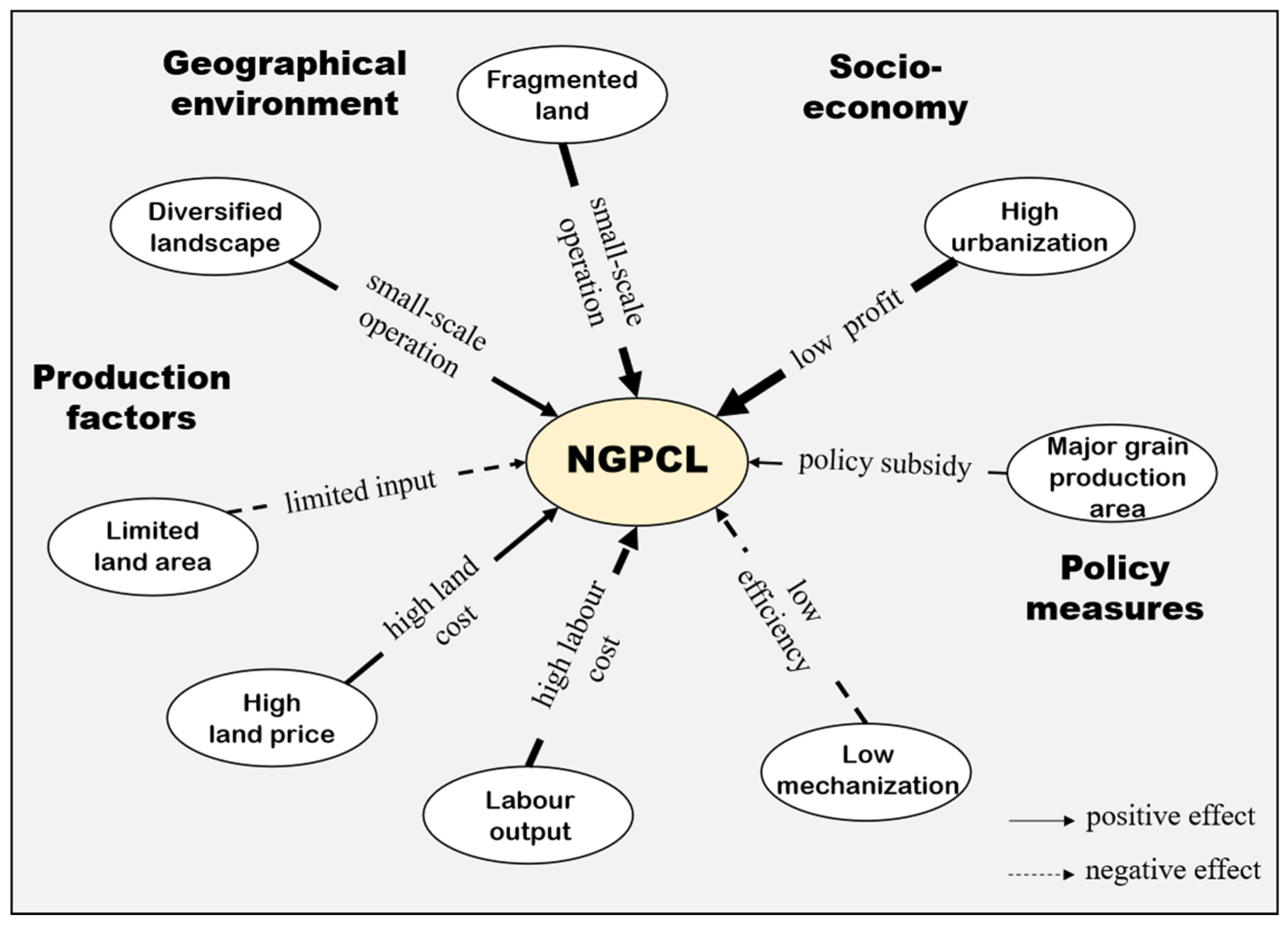
| Variables | Variable Description | References | Mean | Std | Min | Max |
|---|---|---|---|---|---|---|
| Slope (AS) | Percentage of area with a slope greater than 15° | [21,45] | 0.12 | 0.22 | 0.02 | 0.93 |
| Cultivated land fragmentation (CF) | Mean value of homogenization of the mean patch area and patch density | [46,47] | 0.43 | 0.15 | 0 | 0.74 |
| Landscape diversity (LD) | Shannon’s Diversity Index | [47] | 1.67 | 0.46 | 0.64 | 2.44 |
| Cultivated land per capita (CP) | Per capita cultivated area calculated by rural population (hm2/per) | [14,21,48,49] | 0.36 | 0.66 | 0.01 | 5.08 |
| Farmland production potential (FPP) | kg/ha | [30,47] | 2732.72 | 2221.40 | 0.07 | 8367.65 |
| Land Price (LP) | The average of the comprehensive land price of the regional levy area divided by 30 (yuan) | [30] | 1966.24 | 1072.93 | 332.02 | 8683.33 |
| Agricultural employment rates (AER) | Proportion of agricultural workers in rural (%) | [36,50] | 0.45 | 0.16 | 0.05 | 0.87 |
| Agricultural machinery level (AM) | Agricultural machinery power per unit cultivated area (kW·h/hm2) | [9,30,50] | 948.73 | 539.47 | 64.50 | 2727.39 |
| GDP Per Capita (PGDP) | yuan per person | [14,21,45] | 50,516.21 | 25,530.03 | 14,256 | 189,309 |
| Urbanization rate (UR) | % | [14,21,36] | 0.55 | 0.16 | 0.28 | 0.98 |
| Policy (PO) | Main grain producing area = 1; Production and marketing balance area = 2; Main grain marketing area = 3 | [21] | 1.64 | 0.77 | 1 | 3 |
| Variables | OLS | SLM | SEM |
|---|---|---|---|
| AS | 0.015 (0.392) | 0.009 (0.262) | −0.071 (−1.500) |
| CF | 0.172 (3.026) *** | 0.139 (2.626) *** | 0.192 (3.673) *** |
| LD | 0.100 (6.210) *** | 0.088 (5.842) *** | 0.070 (4.791) *** |
| CP | −0.015 (−1.802) * | −0.019 (−2.131) * | −0.026 (2.389) * |
| FPP | −0.011 (−0.597) | −0.009 (−0.510) | −0.015 (−0.522) |
| LP | 0.078(3.402) * | 0.069 (3.237) *** | 0.061 (2.835) *** |
| AER | −0.245 (−5.825) *** | −0.191 (−4.818) *** | −0.175 (−4.887) *** |
| AM | −0.048 (−4.130) *** | −0.054 (−4.950) *** | −0.041 (−3.905) *** |
| PGDP | −0.009 (−0.595) | −0.008 (−0.564) | 0.018 (1.243) |
| UR | 0.332 (4.748) *** | 0.297 (4.568) *** | 0.325 (5.427) *** |
| PO | 0.009 (1.057) | −0.001 (−0.186) | 0.025 (2.040) * |
| W-Y | 0.188 (6.073) *** | ||
| Lambda | 0.601 (12.085) *** | ||
| R2 | 0.852 | 0.868 | 0.889 |
| Log-L | 355.153 | 373.374 | 387.318 |
| AIC | −686.307 | −720.748 | −750.637 |
| SC | −640.289 | −670.896 | −704.620 |
Publisher’s Note: MDPI stays neutral with regard to jurisdictional claims in published maps and institutional affiliations. |
© 2022 by the authors. Licensee MDPI, Basel, Switzerland. This article is an open access article distributed under the terms and conditions of the Creative Commons Attribution (CC BY) license (https://creativecommons.org/licenses/by/4.0/).
Share and Cite
Wang, J.; Dai, C. Identifying the Spatial–Temporal Pattern of Cropland’s Non-Grain Production and Its Effects on Food Security in China. Foods 2022, 11, 3494. https://doi.org/10.3390/foods11213494
Wang J, Dai C. Identifying the Spatial–Temporal Pattern of Cropland’s Non-Grain Production and Its Effects on Food Security in China. Foods. 2022; 11(21):3494. https://doi.org/10.3390/foods11213494
Chicago/Turabian StyleWang, Jieyong, and Chun Dai. 2022. "Identifying the Spatial–Temporal Pattern of Cropland’s Non-Grain Production and Its Effects on Food Security in China" Foods 11, no. 21: 3494. https://doi.org/10.3390/foods11213494
APA StyleWang, J., & Dai, C. (2022). Identifying the Spatial–Temporal Pattern of Cropland’s Non-Grain Production and Its Effects on Food Security in China. Foods, 11(21), 3494. https://doi.org/10.3390/foods11213494






